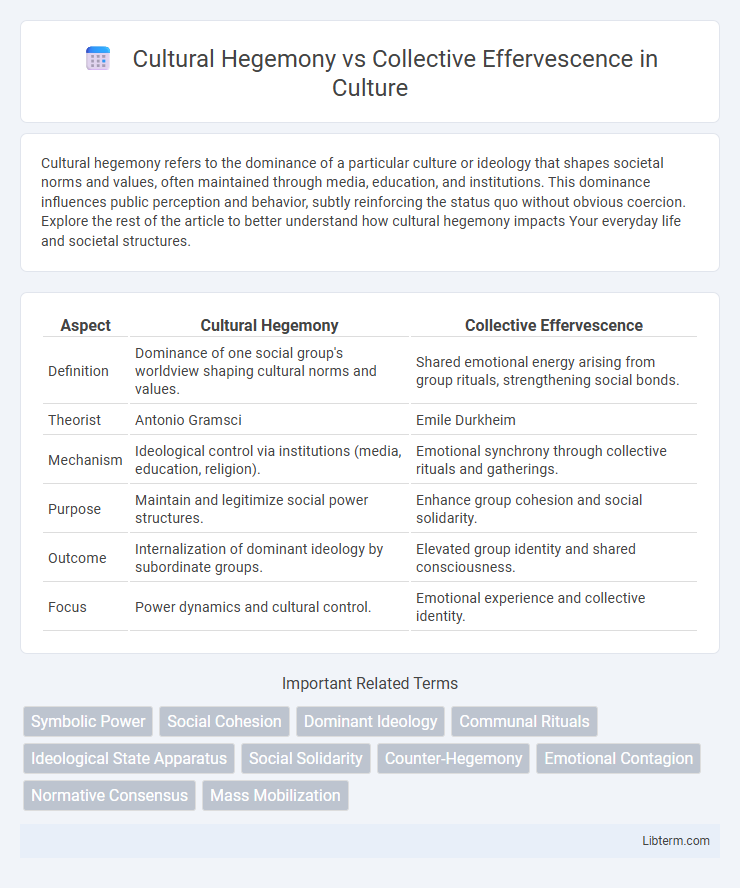Cultural hegemony refers to the dominance of a particular culture or ideology that shapes societal norms and values, often maintained through media, education, and institutions. This dominance influences public perception and behavior, subtly reinforcing the status quo without obvious coercion. Explore the rest of the article to better understand how cultural hegemony impacts Your everyday life and societal structures.
Table of Comparison
| Aspect | Cultural Hegemony | Collective Effervescence |
|---|---|---|
| Definition | Dominance of one social group's worldview shaping cultural norms and values. | Shared emotional energy arising from group rituals, strengthening social bonds. |
| Theorist | Antonio Gramsci | Emile Durkheim |
| Mechanism | Ideological control via institutions (media, education, religion). | Emotional synchrony through collective rituals and gatherings. |
| Purpose | Maintain and legitimize social power structures. | Enhance group cohesion and social solidarity. |
| Outcome | Internalization of dominant ideology by subordinate groups. | Elevated group identity and shared consciousness. |
| Focus | Power dynamics and cultural control. | Emotional experience and collective identity. |
Understanding Cultural Hegemony: Definition and Origins
Cultural hegemony, a concept developed by Antonio Gramsci, refers to the domination of a culturally diverse society by the ruling class, who manipulate the culture to impose their worldview and maintain power. It originates from Marxist theory, emphasizing how ideology and cultural institutions perpetuate social inequalities and control. This concept contrasts with collective effervescence, which describes the shared emotional energy and unity experienced during communal rituals or events.
The Concept of Collective Effervescence Explained
Collective effervescence, a term coined by sociologist Emile Durkheim, describes the intense energy and sense of unity experienced during communal gatherings, where individuals feel connected through shared emotions and rituals. This phenomenon contrasts with cultural hegemony, which refers to the dominant group's control over cultural norms and beliefs to maintain power. Collective effervescence disrupts hegemonic structures by fostering solidarity and emotional bonds that can challenge imposed ideologies.
Historical Contexts: Hegemony and Effervescence in Society
Cultural hegemony, rooted in Antonio Gramsci's theory, describes how dominant groups maintain power through ideological control over society's cultural institutions, shaping historical social structures and class relations. In contrast, Emile Durkheim's concept of collective effervescence emphasizes the spontaneous, unifying energy generated during communal rituals, which reinforces social solidarity and historical continuity within societies. These frameworks highlight differing historical mechanisms: hegemony operates through persistent ideological dominance, while effervescence emerges in episodic social moments fostering collective identity.
Mechanisms of Social Control: Hegemony's Influence
Cultural hegemony operates through the pervasive dominance of ruling class ideologies, subtly shaping societal norms and values to maintain existing power structures. It enforces social control by normalizing beliefs that align with elite interests, ensuring voluntary compliance rather than overt coercion. Collective effervescence contrasts this by fostering shared emotional experiences that temporarily unify groups, reinforcing solidarity without the sustained ideological dominance characteristic of hegemony.
Social Solidarity through Collective Effervescence
Collective effervescence generates intense shared emotions during communal rituals, strengthening social solidarity by fostering a collective consciousness that transcends individual identities. Unlike cultural hegemony, which imposes dominant ideologies through power structures to maintain social order, collective effervescence emerges organically through group participation and emotional synchrony. This spontaneous unity reinforces social bonds and sustains community cohesion, highlighting the emotional foundations of social integration beyond hegemonic control.
Contrasting Forces: Domination vs. Communal Energy
Cultural hegemony refers to the dominance of a ruling class's ideologies and values that shape societal norms and maintain power structures, often suppressing alternative viewpoints. Collective effervescence, a concept introduced by Emile Durkheim, embodies the shared emotional energy and unity experienced by a group during communal rituals, fostering social cohesion and collective identity. These contrasting forces highlight domination through ideological control versus the organic emergence of communal energy that empowers group solidarity and resistance.
Case Studies: Real-World Examples of Both Concepts
Cultural hegemony is exemplified by the dominance of Western media shaping global cultural norms, as seen in the widespread adoption of Western fashion and consumer habits across diverse societies. Collective effervescence manifests vividly during events like the mass gatherings at religious festivals in India or the unified chants at political protests, where shared emotional energy fosters social cohesion. These case studies reveal how cultural hegemony enforces ideological control through dominant narratives, whereas collective effervescence generates spontaneous communal solidarity and identity.
Cultural Narratives: Shaping Belief and Behavior
Cultural hegemony shapes belief and behavior through dominant narratives that reinforce power structures, ensuring societal norms serve ruling elites. Collective effervescence generates shared emotional energy during group rituals, creating a unifying narrative that strengthens social bonds and collective identity. Both processes influence cultural narratives, but hegemony maintains control through ideological dominance while effervescence cultivates communal cohesion via shared experience.
Implications for Social Change and Resistance
Cultural hegemony, as conceptualized by Antonio Gramsci, describes how dominant groups maintain power by normalizing their worldview, limiting social change by shaping ideologies and institutions to suppress dissent. In contrast, Emile Durkheim's notion of collective effervescence refers to the communal energy and shared emotional experiences during collective events, which can inspire social solidarity and mobilize resistance against hegemonic forces. Understanding these dynamics reveals that while cultural hegemony constrains social transformation through ideological control, collective effervescence provides a critical mechanism for fostering solidarity and catalyzing grassroots movements for social change.
Future Perspectives: Navigating Power and Community
Cultural hegemony will likely evolve as digital platforms diversify, allowing marginalized voices to challenge dominant ideologies and reshape societal power dynamics. Collective effervescence, fueled by virtual communities and immersive experiences, promises to strengthen social bonds and shared identities across geographic boundaries. Future research should explore how these phenomena intersect to balance control and communal empowerment in increasingly networked societies.
Cultural Hegemony Infographic

 libterm.com
libterm.com